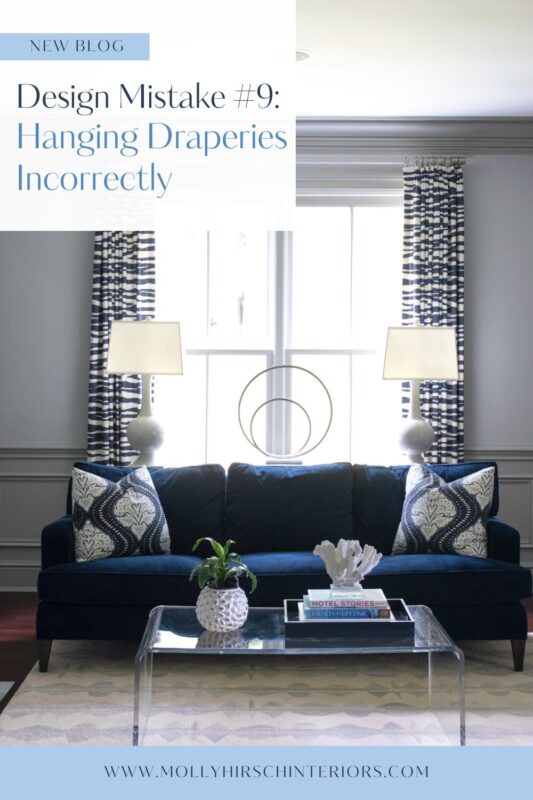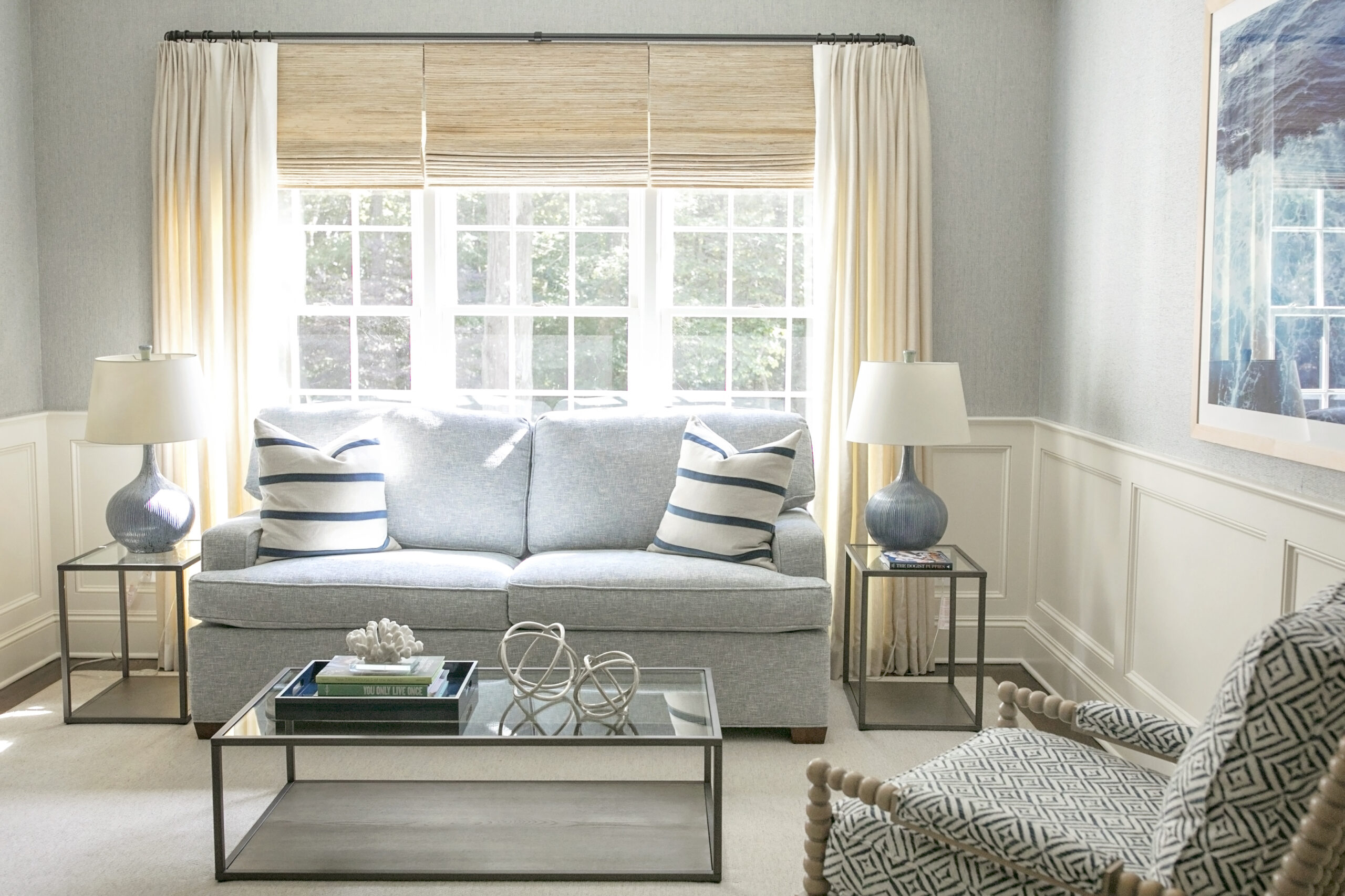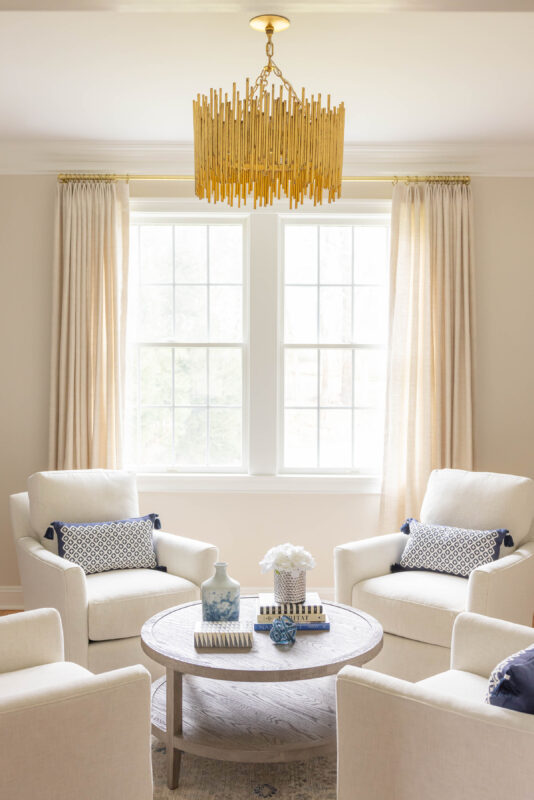
Learn how to style the perfect coffee table.
5 complete looks with shopping links!
Design Mistake #9: Hanging Draperies Incorrectly

Draperies are the perfect way to finish a room. They can add warmth, interest, pattern, and elegance to your space. The possibilities are endless for style, fabric, trim, and hardware. They can be the most dramatic part of a room or fade into the background in elegance.
When hung properly, draperies can give the illusion of higher ceilings and maximize the light in the room.
There are 4 main mistakes people make when hanging draperies, and these lead to opposite results.
1. Hanging draperies too low
I see draperies all the time that are hung just at the top of the window frame, which can create a squatty quality to the window.
Hanging draperies higher will give length to the window and gracefulness to the room.
Here are some general rules of thumb to hanging draperies at the correct height:
- The 2/3 rule. The rod should be hung approximately 2/3 of the way between the top of the window trim and the ceiling.
- If the windows are low, you can use a shade to cover the balance of the wall, giving the illusion of a taller window. The shade should be outside mount, the same width as the window, and mounted just below your drapery rod. Sit the bottom of the shade at the top of the glass of the window. This treatment makes it look like the window is much higher than it is.
- If you have cathedral ceilings, I like to hang the draperies 4-10″ above the window frame.
2. Hanging draperies too narrow on the window
Like above, when people hang at the top of the window frame, they make the mistake of hanging the rod at the same width as the window frame. This leads to the draperies crowding the window and blocking light.
The correct way to hang width-wise is to have the edge of your drapery just at the glass and to stack off from there. The rod should extend beyond the window trim on either side, allowing the drapery to stack properly.
The general rule of thumb is to extend 4-10″ on either side of the window—the variable is based on the window’s size and the draperies’ fullness.

3. Draperies that are too short.
This may be the most bothersome mistake. Hanging draperies that are too short give your room the dreaded high-water pants look—ill-fitting and awkward.
Here are the 4 ways that designers hang draperies
-Kiss the Floor: when the draperies just touch the floor. It’s the most difficult to achieve because the measurements and hanging need to be perfect.
-Just Break: when the draperies “break” onto the floor by 1-2.”
-Puddling: when the draperies “puddle” on the floor—an extra 6-16″ of fabric—a romantic or luxurious look—best with stationary panels.
-Floating: when the draperies are just “floating” above the floor—they should be no more than 1/2″ above the floor.
The right length for your draperies is determined mainly by the look you want and whether the draperies will function.
4. Panels that are too narrow
Having too narrow panels can make the overall look feel skimpy and unfinished—like you ran out of material. When the draperies are closed, you still want some fullness and gather to the panels.
The general rule of thumb is to have draperies that are 2.5 times the width of your window. You need to include the stack amount in this calculation (#2 above).
For example, if your window is 40″ wide, you add 4″ inches per side (8″ total), giving you a width of 48”. Take that 48″ and multiply by 2.5 to get a total drapery width of 120″ or 60″ per side. This is the minimum width you would want your draperies to feel full and proportioned to the window.

Things to keep in mind when buying draperies:
Custom is preferred if possible. These days there are all kinds of versions of “custom” draperies.
- Designer level, where you select all the components, and they are tailor-made to your window.
- Semi-custom, where you can select from a range of fabrics and lining materials, and they are tailor-made to your window.
- Ready-made custom, where you may have a couple of fabric choices, and then you dictate the size you want them.
There is a great debate about draperies—whether you need draperies to finish a room.
I believe it depends on the room: the function, the overall look, and the formality.
But, I will say that I would much prefer a room without draperies to a room with draperies that are not hung or fitted correctly. Nothing brings down the look of a room like ill-fitted draperies–it’s the room equivalent of an ill-fitted suit.
For more inspiration follow along with us on Pinterest.
You’ve just read Design Mistake #9, don’t miss the rest of the Design Mistake series:
#1 Keeping Things You Don’t Love

Hi, I’m Molly Hirsch, and I help women founders, executives, and entrepreneurs translate their highly effective work approach to their home design, creating a space that rises up to meet their needs while enhancing the warmth and style of their family home. Discover all the ways we can work together to create a home of your dreams.
